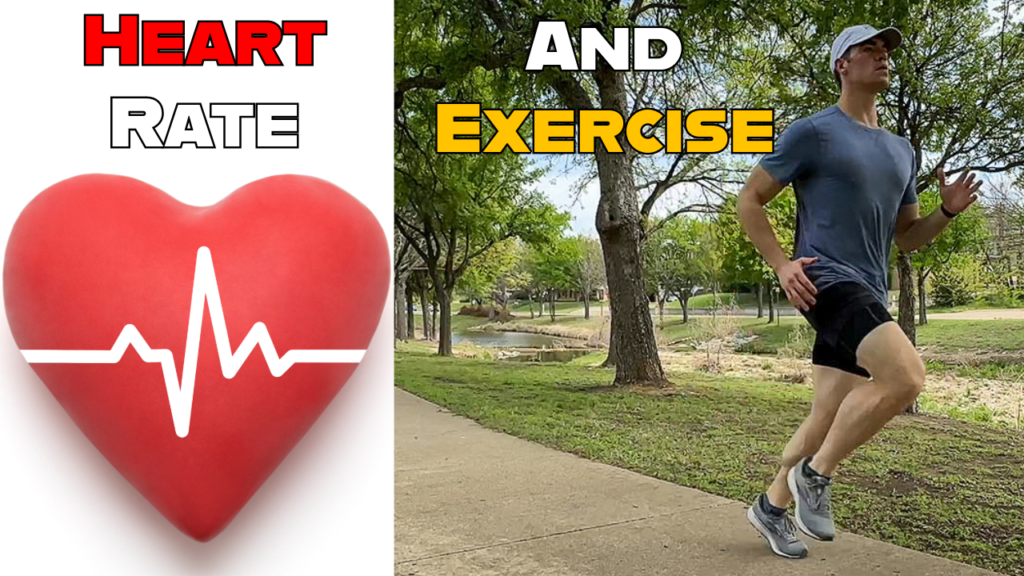Finding a reliable and easy way to measure intensity while exercising can be challenging. Heart rate can serve as a quick tool to guide your workout intensity. By finding your maximum heart rate, you can estimate what heart rate you should have based on a predetermined training goal.
Find your Maximum Heart Rate (MHR)
The most common equation is MHR=(220 – age). However, the MHR= 208 − (0.7 × age) equation may be more accurate (1,2). Ex: For a 23-year-old, this would be 208 – (.7 x 23) = ~ 192 beats per minute. Without a field test to find the true value, all equations based on age will carry some error and either under or overestimate true MHR.
Heart Rate Reserve (HRR)
The difference between your maximum and resting heart rate, RHR.
MHR – RHR = HRR Ex: (192) – (40) = (152)
ACSM guidelines(4):
Light: 30-39% HRR
Moderate: 40-59% of HRR
Vigorous: 60-89% of HRR
Target Heart Rate (THR)
THR = RHR + (HRR) x % range
Ex: For 65-85% intensity
THR = (152 X .65) + 40= ~ 139
(152 X .85) + 40= ~ 169
For 65-85% intensity, the heart rate would stay between 139-169 beats.
-
-
Zone 1
-
Purpose:
-
Zone one intensity is used for recovery and metabolic fatigue resistance.
-
-
Intensity:
-
50-60% of HR max
-
Ex: 96-115 BPM for a 23-year-old
-
-
Examples:
-
Brisk walking, golfing, and light housework.
-
-
Protocol:
-
Spend at least 10-60 minutes each day in this zone to enjoy the benefits of a more active lifestyle.
-
-
-
-
-
Zone 2
-
Purpose:
-
This zone adapts your cardiovascular capacity over months of training. This intensity improves mitochondrial function by approaching the anaerobic threshold while maintaining a lower intensity. You may notice a once difficult intensity becomes much easier as your heart, lungs, and muscles adapt to the activity over months.
-
-
Intensity:
-
60-70% of HR max.
-
A quick rule of thumb to know if you’re in zone 2 is the talk test. You should be able to talk with a training partner with almost no difficulty. Many new runners believe that more intensity is better. This leads them to run their easy runs in zone three which stimulates unnecessary stress on their body.
-
Ex: 115-134 BPM for a 23 – year old.
-
-
Examples:
-
Brisk walking, jogging, biking.
-
-
Protocol:
-
Duration: 30 minutes – 2 hours 2-4 times a week. Or 1-2 hours 3-4 times a week for 12 weeks.
-
-
-
-
-
Zone 3
-
Purpose:
-
Zone three is for speed training and endurance capacity. Run faster and farther at the same time.
-
-
Intensity:
-
70-80% MHR
-
Ex: 134-154 BPM for a 23-year-old
-
These runs are too intense to serve as your easy runs.
-
-
Protocol:
-
Tempo runs to practice target race pace. 15-60 minutes at 5k-marathon race pace.
-
To avoid injury, zone 3 should be spaced with plenty of recovery.
-
-
-
-
-
Zone 4
-
Purpose:
-
Lactate threshold or anaerobic threshold to improve speed.
-
-
Intensity
-
80-90% MHR
-
Ex: 154-173 BPM for a 23 year old
-
-
Protocol
-
2 X 20-minute threshold runs.
-
-
-
Zone 5
-
Purpose:
-
Increases the maximum amount of oxygen you can consume or VO2 max.
-
Target for high-intensity interval training
-
-
Intensity
-
90-100% MHR
-
Ex: 173 – 192 BPM for a 23 year old.
-
-
Protocol: 4 reps of 4 min on 4 min off biking, swimming, or running.
-
4 minutes on at 85-95% peak HR
-
Aim to get 4-9% of your total training above 90% of your HR max (4).
-
-
-
-
Cardiovascular Drift
- As you continually exercise over 20 minutes, your heart rate may progressively increase at the same intensity. This is due to a reduction in blood volume ejected in each beat due to dehydration. Rehydration is a good strategy to minimize this elevated heart rate (3).
MY KEY LINKS:
- 💡 YouTube – https://www.youtube.com/@cartergansky
- 📸 Instagram – https://www.instagram.com/carter.r.gansky/
- 🐦 Twitter – https://twitter.com/CarterGansky
- 🌲 Linktree – https://linktr.ee/cartergansky
- 🔊 Discord – https://discord.gg/sQxvHH78Ga
WHO AM I:
I’m Carter Gansky, a fitness and health advocate and a Doctor of Physical Therapy in training. I explore the strategies and tools that help us live motivating, healthier, and more fulfilling lives.
GET IN TOUCH:
🧠 contactcartergansky@gmail.com
For collaborations or other business inquiries.
References
-
Tanaka, H., Monahan, K. D., & Seals, D. R. (2001). Age-predicted maximal heart rate revisited. Journal of the American College of Cardiology, 37(1), 153–156. https://doi.org/10.1016/s0735-1097(00)01054-8
-
Association, N.-N. S. & C. (Ed.). (2021). Essentials of Strength Training and Conditioning (Fourth edition). Human Kinetics.
-
Povea, C. E., & Cabrera, A. (2018). Practical usefulness of heart rate monitoring in physical exercise. Revista Colombiana de Cardiología, 25(3), e9–e13. https://doi.org/10.1016/j.rccar.2018.05.004
-
Medicine, A. C. of S. (2017). ACSM’s Guidelines for Exercise Testing and Prescription (10th edition). LWW.
-
Zhu, Z., Li, H., Xiao, J., Xu, W., & Huang, M.-C. (2022). A fitness training optimization system based on heart rate prediction under different activities. Methods, 205, 89–96. https://doi.org/10.1016/j.ymeth.2022.06.006



